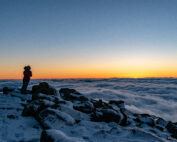Slinging Science!
2018-03-09 13:39:51.000 – Sarah Schulte, Summit Intern
Every hour for the past 85 years, one of Mount Washington’s weather observers has stepped out onto the Observatory’s deck to take a manual weather observation. In addition to noting visibility and cloud formations, they also use an instrument called a sling psychrometer to take wet-bulb and dry-bulb temperature measurements, which are important for calculating relative humidity (the amount of water vapor present in the air). On a day when the summit is shrouded in fog, the air is completely saturated and has a relative humidity of 100%. On any other day, however, this measurement needs to be taken.

Taking a measurement with the sling psychrometer.
A sling psychrometer is made up of two thermometers attached to a spinning handle: a dry-bulb thermometer, which is identical to a typical thermometer, and a wet-bulb thermometer, which has a piece of wet cloth wrapped around the end. To take a reading, the sling psychrometer is slung around in circles, and water begins to evaporate out of the cloth at the end of the wet-bulb thermometer.
When water evaporates, it changes from a lower-energy state (liquid water) to a higher-energy state (water vapor). In order to achieve this higher state, the water molecules need energy, and so they take it from their environment in the form of heat. As more and more water evaporates from the end of the wet-bulb thermometer, more heat is taken from it and the temperature reading drops. When the air can’t hold any more water vapor, water stops evaporating from the end of the thermometer and we have our wet-bulb temperature! A day with higher humidity will have a wet-bulb temperature closer to the dry-bulb temperature, because less water will evaporate from the end of the thermometer and less heat will be removed.
This process is similar to how the human body regulates its temperature. When the body starts to grow too hot, it produces sweat. The sweat evaporates, taking heat away from the body and cooling it down. This is why a humid day feels more uncomfortable than a dry day: the body can’t rid itself of excess heat by evaporating all of its sweat. Take extra care on humid days to avoid overheating!
Sarah Schulte, Summit Intern
From Mountains to More Mountains
From Mountains to More Mountains: This Time with Stronger Winds By Alyssa Bélanger On the observation deck in high winds. Hello there! My name is Alyssa Bélanger and I am a fall
From Summit to Sign-Off: My Farewell to the Rockpile
From Summit to Sign-Off: My Farewell to the Rockpile By Amy Cotter Enjoying my last Mount Washington sunset (for now) on September 13, 2025. After two incredible years with the Mount Washington
Trail Report: Seek the Peak Hikes 16 and 17!
Trail Report: Seek the Peak Hikes 16 and 17! By Chris Nichols September 22, 2025 – Summit 16 of 17 A chilly morning turned into a spectacular day on Mount Washington. The thermostat in




